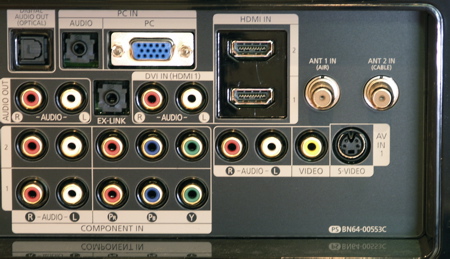Samsung LN-T4671F LCD TV Setup & Tests
Setting up the LN-T4671F was straightforward. The Movie picture mode was fairly close to the D65 grayscale standard, and the color primaries and secondaries weren't far off at all (see Measurements).

Starting with the HQV Benchmark DVD at 480i via component, detail was excellent, but jaggies were not—they were moderate on the rotating bar and waving flag and severe on the three oscillating bars. The TV's Digital NR (noise reduction) control worked well in its Low setting, and higher settings didn't improve things much beyond that. The processor picked up 3:2 pulldown quickly and reliably, though 2:2 video was quite jittery. Switching to the Spears & Munsil test HD DVD at 1080i via HDMI, the set picked up 3:2 almost immediately.
On the HQV Benchmark HD DVD at 1080i via HDMI, I found the TV's Digital NR control to have little effect on noise. The video-resolution loss test was solid as a rock, and jaggies were invisible. The set took a moment to lock onto the film-resolution loss test, and there was slight flickering in the middle horizontal burst. Also, there was a moderate loss of detail in the pan across the bleachers.
The FPD For Professionals Blu-ray test disc provides some excellent clips to evaluate a flat-panel display's motion rendering and other characteristics. Auto Motion Plus did clean up moving objects quite a bit, but it also introduced some serious artifacts in certain types of images.
For example, it sharpened the horizontally scrolling monoscope pattern, but the horizontal and diagonal bursts were full of distortion artifacts. Turning AMP off removed the artifacts, but the motion was a lot blurrier. AMP did improve the horizontally scrolling characters and map as well as the swinging hammock and metronome without problems, but the artifacts are so obvious when they appear that I tended to leave AMP off.
This disc also includes smooth ramps to test gradation performance. The 0-100% ramp had slight banding, while the 0-25% ramp had more. I've never seen a flat panel with no banding on these tests, and the Samsung's performance on them was about average. The subtle variations in the largely black and mostly white still images were well-rendered.
As I was testing the LN-T4671F, I noticed a few miscellaneous things of interest. Black-field uniformity was very good, as was off-axis performance, though very dark scenes did lose a bit of contrast when I was far off to the side. Interestingly, the front of the screen seemed a bit more reflective than most LCD TVs I've seen—in fact, it reminded me more of a plasma in that regard.
Finally, connecting the TV to a Samsung BD-P1200 Blu-ray player engaged CEC (Consumer Electronics Control), a feature of HDMI 1.3 that integrates the operation of compatible devices connected via HDMI. When I turned either one off, the other responded in kind. Interestingly, when I turned the TV on, the player did not turn on as well.























































